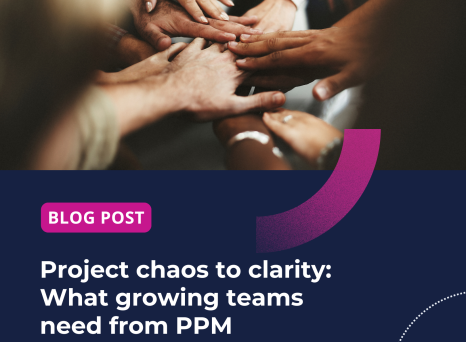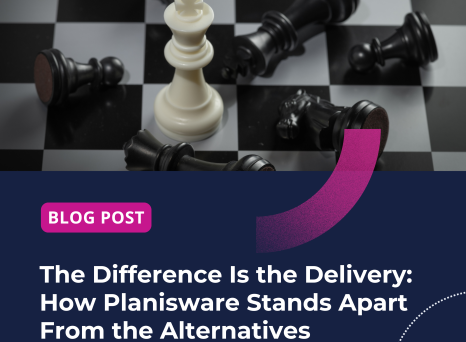So, you’ve come to the conclusion that it’s time to embark on a new Project Portfolio Management (PPM) solution. You’ve identified that spreadsheets are no longer working for your team’s needs, as you’re tired of digging through email chains. To facilitate growth achieved by smarter decisions with the up-to-date information you need at your fingertips, you’re looking for a solution that centralises all your projects in one place.
Planisware offers two powerful SaaS solutions: Orchestra and Enterprise. Each of these tools are designed for a different stage of PPM maturity. This comparison guide breaks down the core differences in fit, functionality, and scalability to help you choose the right platform for your business.
An overview of each PPM solution
Both Planisware Orchestra and Enterprise centralise project and portfolio data to give you the confidence to make backed decisions that will ultimately lead to amazing outcomes.
Introducing Orchestra, the agile PPM for teams that need speed and simplicity
Planisware Orchestra is a cloud-based Project Portfolio Management (PPM) solution designed to help organisations move quickly from fragmented project tracking to real-time, centralised oversight that has a clear structure. It brings all stakeholders together on a single platform, providing a clear connection of strategy with all the details that usually fill up files and notes on personal drives and Teams messages.
A huge consideration in the creation of Orchestra was providing businesses with the ability to make the platform their own and keep using it as their growing business needs evolve. With countless features, you can customise dashboards and reporting exactly the way you need it:
Create projects from templates
Manage average costs
Optimise resource workflow
Demand lifecycle management
Action plan management
Edit balance sheets
Planisware Enterprise: Strategic PPM for global, cross-functional portfolios
As your business scales up, once straightforward processes for a smaller team now come with brand new complexities. Having a secure tool with everything in one place saves masses of time and money in decision-making processes. Planisware Enterprise brings together everything you need to successfully manage complex projects across large, multi-layered organisations. Designed for maturity, it powers long-term planning and execution while providing deep configurability and advanced governance.
Examples of Enterprise’s capabilities:
Strategic planning: Investment scenario building and evaluation, promotion workflow, and objectives definition, visualisation and communication.
Resource & cost management: Rich resource status visibility, dynamic what-if scenario modelling, and AI cost modelling & parametric estimation.
Project execution & work delivery: AI risk identification, messaging & social networking, project scheduling.
Breaking down the differences
Capability | Planisware Orchestra | Planisware Enterprise |
|---|---|---|
The ideal organisation | It’s ideal for mid-sized organisations or departments scaling their delivery capabilities and seeking a unified view of project performance. | Built for large, complex enterprises managing strategic portfolios across multiple business units, regions, or functions. Enterprise acts as the central nervous system for strategy execution. |
Strategic alignment | Orchestra brings strategy to life through intuitive dashboards and configurable KPIs, allowing teams to visualise how their projects contribute to business goals. It supports prioritisation and governance but remains light enough for organisations building PPM maturity. | Enterprise delivers true Strategic Portfolio Management (SPM). It allows executives to define objectives and follow these to completion with data-driven strategic planning. |
Portfolio management | Orchestra gives teams a clear view of project portfolios through configurable dashboards. Teams can instantly assess their workloads and financial status while keeping stakeholders informed. The platform supports collaboration in real time and makes oversight straightforward without requiring complex setup. | It supports multi-tier portfolio structures, programme-level management, and investment scenario evaluation. Decision-makers can compare multiple portfolio configurations using AI-assisted simulations and waterline analysis to identify the most valuable mix of initiatives. This enables strategic prioritisation at scale. |
Project planning | Orchestra supports hybrid work environments where agile and traditional teams coexist. Users can manage timelines through Gantt charts, track sprints and Kanban boards, and leverage templates for repeatable success. It’s highly visual and team oriented. | Enterprise offers multi-methodology execution by integrating seamlessly with Jira, Aha!, and Azure DevOps, ensuring visibility from agile teams up to portfolio leadership. Its AI-assisted Work Breakdown Structure (WBS) creation, dependency management, and phase-gate governance allow enterprises to coordinate large, multi-project programmes with precision. |
Resource management | Managers can allocate people by skill, monitor workloads, and visualise bottlenecks across teams. Time-tracking and utilisation dashboards make it easy to maintain operational efficiency without complexity. | With Enterprise’s AI-driven forecasting and resource analysis, PMOs can simulate future demand by testing staffing scenarios and modelling organisational changes. This empowers leaders to optimise workforce allocation in real time. |
Financial management | Orchestra offers straightforward budget management and cost tracking, enabling teams to monitor spend by currency, department, or man-days. | Enterprise delivers comprehensive financial governance. It integrates directly with ERP systems (including SAP-certified connectors), supports multi-currency budgeting, and enables both top-down and bottom-up modelling. |
Analytics & reporting | Reporting in Orchestra is designed for speed and accessibility. Data is presented clearly for decision-makers who need reliable updates on project health. | Enterprise elevates analytics to an enterprise standard. Its Planisware Explorer enables interactive reporting and ad |
Collaboration | Collaboration is Orchestra’s cornerstone. It unites every stakeholder within one interface. Built-in communication tools, notifications, and document sharing eliminate silos and ensure everyone is working from the same source of truth. | Enterprise expands collaboration into a structured governance model for transparency. It includes advanced cross-functional workflow automation. With integrated messaging, version control, and role-based access. |
Integration & deployment | Orchestra is highly configurable through Orchestra Designer, allowing users to tailor forms and triggers without code. It connects easily to both HR and finance effortlessly. Deployment is fast, available in SaaS or on-premise models hosted on ISO 27001 and SOC 2 Type II certified servers. | With 70+ native connectors, REST APIs, and support for complex data models, it can integrate seamlessly across ERP, CRM, and HRMS ecosystems. Available as SaaS or on-premise, Enterprise provides enterprise-grade scalability, security, and multi-language support. |
AI features | Orchestra incorporates AI in a lightweight way, primarily for reporting acceleration, KPI forecasting, and data visualisation. It helps teams focus on performance without complexity. | Enterprise embeds AI across the portfolio lifecycle. Its predictive models optimise resource use, forecast capacity, and balance investment portfolios using advanced algorithms like particle swarm optimisation. These features help executives make faster, evidence-based decisions with greater confidence. |
Scalability | Orchestra scales effortlessly from team-level use to cross-departmental adoption. It’s ideal for organisations with 100–1,000 users, looking to build PPM maturity and harmonise project delivery across teams. | Enterprise is designed for global scalability, supporting thousands of users and multiple portfolios. It provides the governance and infrastructure needed to sustain enterprise-wide transformation and strategic growth. |
Considerations for choosing the right PPM solution
Choosing the right PPM solution isn’t just about comparing features; it’s about aligning technology with your organisation’s culture and goals. It’s helpful to review what your current pain points are, such as forgotten tasks or conflicting priorities to help you envision how a new PPM platform will better equip your team long-term.
Knowing where you are in your maturity level and what your growth aspirations are is fundamental for making the right decision. The Planisware team is on hand to provide personalised demos of each solution, listening to your requirements and showing you exactly how Orchestra or Enterprise can transform your business. Speak to us today.


